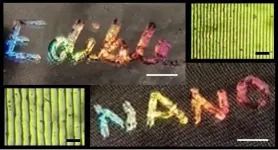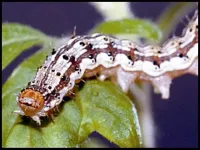Do sweat it! Wearable microfluidic sensor to measure lactate concentration in real time
Scientists develop new biosensing device to chemically monitor the state of muscles during physical exercise
2021-02-17
(Press-News.org) With the seemingly unstoppable advancement in the fields of miniaturization and materials science, all sorts of electronic devices have emerged to help us lead easier and healthier lives. Wearable sensors fall in this category, and they have received much attention lately as useful tools to monitor a person's health in real time. Many such sensors operate by quantifying biomarkers, that is, measurable indicators that reflect one's health condition. Widely used biomarkers are heartrate and body temperature, which can be monitored continuously with relative ease. On the contrary, chemical biomarkers in bodily fluids, such as blood, saliva, and sweat, are more challenging to quantify with wearable sensors.
For instance, lactate, which is produced during the breakdown of glucose in the absence of oxygen in tissues, is an important biomarker present in both blood and sweat that reflects the intensity of physical exercise done as well as the oxygenation of muscles. During exercise, muscles requiring energy can rapidly run out of oxygen and fall back to a different metabolic pathway that provides energy at the 'cost' of accumulating lactate, which causes pain and fatigue. Lactate is then released into the bloodstream and part of it is eliminated through sweat. This means that a wearable chemical sensor could measure the concentration of lactate in sweat to give a real-time picture of the intensity of exercise or the condition of muscles.
Although lactate-measuring wearable sensors have already been proposed, most of them are composed of materials that can cause irritation of the skin. To address this problem, a team of scientists in Japan recently carried out a study to bring us a more comfortable and practical sensor. Their work, which was published in Electrochimica Acta, was led by Associate Professor Isao Shitanda, Mr. Masaya Mitsumoto, and Dr. Noya Loew from the Department of Pure and Applied Chemistry at the Tokyo University of Science, Japan.
The team first focused on the sensing mechanism that they would employ in the sensor. Most lactate biosensors are made by immobilizing lactate oxidase (an enzyme) and an appropriate mediator on an electrode. A chemical reaction involving lactate oxidase, the mediator, and free lactate results in the generation of a measurable current between electrodes--a current that is roughly proportional to the concentration of lactate.
A tricky aspect here is how to immobilize the enzyme and mediator on an electrode. To do this, the scientists employed a method called "electron beam-induced graft polymerization," by which functional molecules were bonded to a carbon-based material that can spontaneously bind to the enzyme. The researchers then turned the material into a liquid ink that can be used to print electrodes. This last part turns out to be an important aspect for the future commercialization of the sensor, as Dr. Shitanda explains, "The fabrication of our sensor is compatible with screen printing, an excellent method for fabricating lightweight, flexible electrodes that can be scaled up for mass production."
With the sensing mechanism complete, the team then designed an appropriate system for collecting sweat and delivering it to the sensor. They achieved this with a microfluidic sweat collection system made out of polydimethylsiloxane (PDMS); it comprised multiple small inlets, an outlet, and a chamber for the sensor in between. "We decided to use PDMS because it is a soft, nonirritating material suitable for our microfluidic sweat collection system, which is to be in direct contact with the skin," comments Mr. Mitsumoto.
The detection limits of the sensor and its operating range for lactate concentrations was confirmed to be suitable for investigating the "lactate threshold"--the point at which aerobic (with oxygen) metabolism turns into anaerobic (without oxygen) metabolism during exercise. Real-time monitoring of this bodily phenomenon is important for several applications, as Dr. Loew remarks, "Monitoring the lactate threshold will help optimize the training of athletes and the exercise routines of rehabilitation patients and the elderly, as well as control the exertion of high-performance workers such as firefighters."
The team is already testing the implementation of this sensor in practical scenarios. With any luck, the progress made in this study will help develop the field of wearable chemical sensors, helping us to keep better track of our bodily processes and maintain better health.
INFORMATION:
About The Tokyo University of Science
Tokyo University of Science (TUS) is a well-known and respected university, and the largest science-specialized private research university in Japan, with four campuses in central Tokyo and its suburbs and in Hokkaido. Established in 1881, the university has continually contributed to Japan's development in science through inculcating the love for science in researchers, technicians, and educators.
With a mission of "Creating science and technology for the harmonious development of nature, human beings, and society", TUS has undertaken a wide range of research from basic to applied science. TUS has embraced a multidisciplinary approach to research and undertaken intensive study in some of today's most vital fields. TUS is a meritocracy where the best in science is recognized and nurtured. It is the only private university in Japan that has produced a Nobel Prize winner and the only private university in Asia to produce Nobel Prize winners within the natural sciences field.
Website: https://www.tus.ac.jp/en/mediarelations/
About Associate Professor Isao Shitanda from Tokyo University of Science
Dr. Isao Shitanda graduated from Tokyo University of Science in 2001 and then got a PhD from The University of Tokyo, Japan, in 2006. Since 2012, he is an Associate Professor of the Department of Pure and Applied Chemistry at Tokyo University of Science, where he leads the Itagaki/Shitanda lab. He specializes in electrochemical micro/nanosystems, physical and analytical chemistry, bio-related chemistry, and environmental chemistry, among other fields. He has published over 180 papers and holds seven patents.
Funding information
This study was partially supported by JST-ASTEP (Grant No. JPMJTS1513), JSPS (Grant No. 17H02162), the Private University Research Branding Project (2017-2019) from the Ministry of Education, Culture, Sports, Science and Technology, and the Tokyo University of Science Grant for President's Research Promotion.
Media contact
Tsutomu Shimizu
Email: mediaoffice@admin.tus.ac.jp
[Attachments] See images for this press release:

ELSE PRESS RELEASES FROM THIS DATE:
2021-02-17
Holograms are everywhere, from driver's licenses to credit cards to product packaging. And now, edible holograms could someday enhance foods. Researchers reporting in ACS Nano have developed a laser-based method to print nanostructured holograms on dried corn syrup films. The edible holograms could also be used to ensure food safety, label a product or indicate sugar content, the researchers say.
Most holograms are imprinted with lasers onto metal surfaces, such as aluminum, but the materials aren't edible. For foods, holograms made with nanoparticles have been proposed, but the tiny particles can generate reactive oxygen species, which might be harmful for people to eat. In a different approach, food scientists have ...
2021-02-17
ROCHESTER, Minn. -- A new study by Mayo Clinic researchers has identified that a chromosome instability gene, USP24, is frequently missing in pediatric patients with neuroblastoma, an aggressive form of childhood cancer. The finding provides important insight into the development of this disease. The study is published in Cancer Research, the journal of the American Association for Cancer Research.
"Neuroblastoma is a highly aggressive cancer that nearly exclusively affects young children," says Paul Galardy, M.D., a pediatric hematologist and oncologist at Mayo Clinic. Despite the use of multiple treatment approaches, Dr. Galardy says many children die of this disease every year.
To identify new ...
2021-02-17
A mutation in the spike protein of SARS-CoV-2--one of several genetic mutations in the concerning variants that have emerged in the United Kingdom, South Africa, and Brazil--makes the virus up to eight times more infectious in human cells than the initial virus that originated in China, according to research published in the journal END ...
2021-02-17
Scientists have discovered a never-before-seen biodiversity pattern of coral reef fishes that suggests some fishes might be exceptionally vulnerable to environmental change.
A new study shows plankton-eating coral reef fishes (planktivores) are far more diverse than others in the Indo-Australian Archipelago, a global marine biodiversity hotspot.
The findings highlight, for the first time, a unique link between the diet and distribution of species across the marine realm.
"The archipelago is one of the most complex and dynamic geological regions in the tropics," said lead author Dr Ale Siqueira from the ARC Centre of Excellence for Coral Reef Studies at James Cook University (Coral CoE at JCU). "And its ...
2021-02-17
Teens who bully, harass, or otherwise victimize their peers are not always lashing out in reaction to psychological problems or unhealthy home environments, but are often using aggression strategically to climb their school's social hierarchy, a University of California, Davis, study suggests. These findings point to the reasons why most anti-bullying programs don't work and suggest possible strategies for the future.
"To the extent that this is true, we should expect them to target not vulnerable wallflowers, but their own friends, and friends-of-friends, who are more ...
2021-02-17
UNIVERSITY PARK, Pa. -- Like a scene from a horror movie, tomato fruitworm caterpillars silence their food plants' cries for help as they devour their leaves. That is the finding of a multidisciplinary team of researchers, who said the results may yield insights into the abilities of crop plants -- such as tomato and soybean -- to withstand additional stressors, like climate change.
"We have discovered a new strategy whereby an insect uses saliva to inhibit the release of airborne plant defenses through direct manipulation of plant stomata," said Gary Felton, professor and head of the Department of Entomology at Penn State, noting that stomata are tiny pores on plant leaves that regulate gas exchange, including plant defensive emissions ...
2021-02-17
Wheat straw, the dried stalks left over from grain production, is a potential source of biofuels and commodity chemicals. But before straw can be converted to useful products by biorefineries, the polymers that make it up must be broken down into their building blocks. Now, researchers reporting in ACS Sustainable Chemistry & Engineering have found that microbes from the guts of certain termite species can help break down lignin, a particularly tough polymer in straw.
In straw and other dried plant material, the three main polymers -- cellulose, hemicelluloses and lignin -- are interwoven into a complex 3D structure. The first two polymers are polysaccharides, which can be broken down into sugars and then converted to fuel in bioreactors. ...
2021-02-17
Humans, like most social animals, tend to be organized hierarchically. In any group or social relationship there are always individuals who, for various reasons, significantly influence the behaviour of others. These individuals are attributed the highest status within the social group they belong to. As everyday examples of hierarchical relationships we find those of parents and children, teachers and students, bosses and workers, etc.
Given the pervasiveness of such social organization, in recent years studies have begun to ascertain how and when children begin to recognize which people have higher and which have lower social status. Specifically, ...
2021-02-17
Prolonged anesthesia, also known as medically induced coma, is a life-saving procedure carried out across the globe on millions of patients in intensive medical care units every year.
But following prolonged anesthesia--which takes the brain to a state of deep unconsciousness beyond short-term anesthesia for surgical procedures--it is common for family members to report that after hospital discharge their loved ones were not quite the same.
"It is long known that ICU survivors suffer lasting cognitive impairment, such as confusion and memory loss, that can languish for months and, in some cases, years," said Michael Wenzel, MD, lead author of a study published in PNAS this month that documents changes associated with prolonged anesthesia in the brains of mice.
Wenzel, a former ...
2021-02-17
The Mongolian Cyclone is a major meteorological driving force across southeast Asia. This cyclone is known for transporting aerosols, affecting where precipitation develops. Meteorologists are seeking ways to improve seasonal prediction of the relationship between the Mongolian cyclone and South Asia high. These features are major components of the East Asian summer monsoon (EASM) and the corresponding heavy rain events. New research suggests that analyzing these phenomena in the upper-level atmosphere will enhance the summer rainfall forecast skill in China.
"The lower seasonal predictability of EASM may happen when the coupling wheel of Mongolian cyclone and South Asia high prevails over East Asia." said Prof. ...
LAST 30 PRESS RELEASES:
[Press-News.org] Do sweat it! Wearable microfluidic sensor to measure lactate concentration in real time
Scientists develop new biosensing device to chemically monitor the state of muscles during physical exercise





